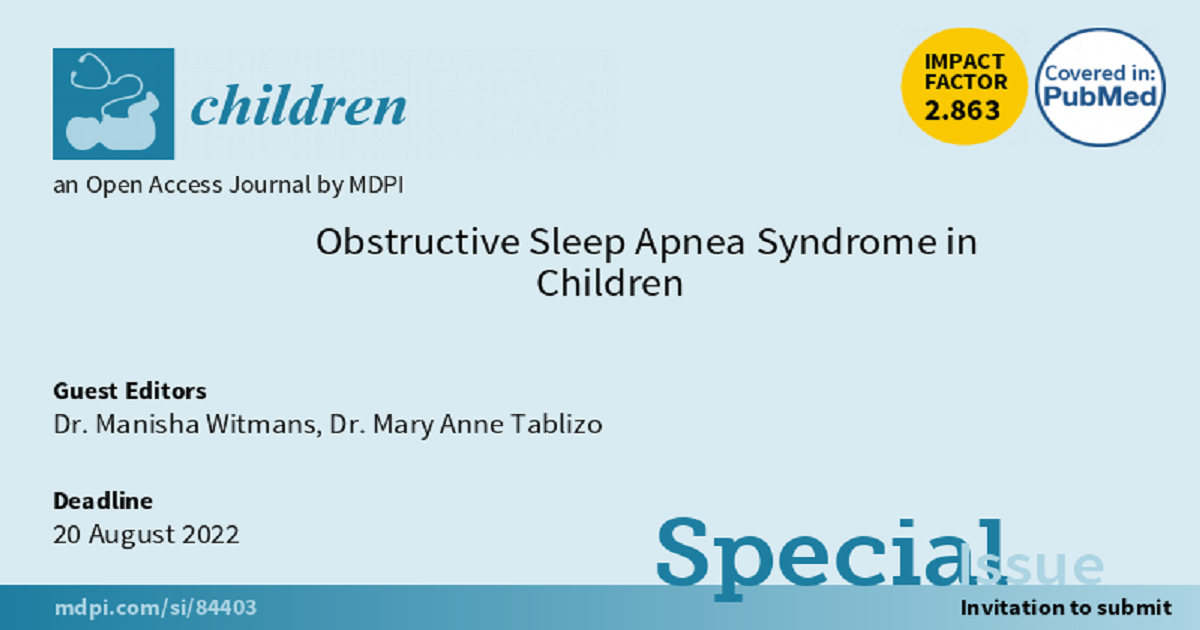Obstructive Sleep Apnea Syndrome in Children
A special issue of Children (ISSN 2227-9067). This special issue belongs to the section "Pediatric Pulmonary and Sleep Medicine".
Deadline for manuscript submissions: closed (20 August 2022) | Viewed by 46559

Special Issue Editors
Interests: obstructive sleep apnea; clinical sleep disorders; craniofacial development; systemic inflammation and sleep disorders
Special Issues, Collections and Topics in MDPI journals
Interests: pediatric obstructive sleep apnea; clinical sleep disorders; sleep disordered breathing
Special Issues, Collections and Topics in MDPI journals
Special Issue Information
Dear Colleagues,
Obstructive sleep apnea is a common sleep disorder in children with a prevalence of 1–6%. Children can be affected from birth to adulthood. Many sequalae have been linked to untreated obstructive sleep apnea and include cognitive deficits, poor emotional regulation and failure to thrive. Emerging evidence has shown that obstructive sleep apnea is linked to various systemic conditions such as cardiovascular dysfunction, obesity, insulin resistance, systemic inflammation, and worsening asthma control. Children that are born premature and from disadvantaged backgrounds have a higher prevalence. There is also a familial predisposition to the condition. Removal of the tonsils and adenoids is currently the treatment of choice in children, but evidence suggests that not all children are actually cured by surgery. Emerging treatment options are being explored as is the possibility of identifying risk factors early in the condition. This series of articles will explore the most recent evidence for both identifying and treating obstructive sleep apnea in children.
Dr. Manisha Witmans
Dr. Mary Anne Tablizo
Guest Editors
Manuscript Submission Information
Manuscripts should be submitted online at www.mdpi.com by registering and logging in to this website. Once you are registered, click here to go to the submission form. Manuscripts can be submitted until the deadline. All submissions that pass pre-check are peer-reviewed. Accepted papers will be published continuously in the journal (as soon as accepted) and will be listed together on the special issue website. Research articles, review articles as well as short communications are invited. For planned papers, a title and short abstract (about 100 words) can be sent to the Editorial Office for announcement on this website.
Submitted manuscripts should not have been published previously, nor be under consideration for publication elsewhere (except conference proceedings papers). All manuscripts are thoroughly refereed through a single-blind peer-review process. A guide for authors and other relevant information for submission of manuscripts is available on the Instructions for Authors page. Children is an international peer-reviewed open access monthly journal published by MDPI.
Please visit the Instructions for Authors page before submitting a manuscript. The Article Processing Charge (APC) for publication in this open access journal is 2400 CHF (Swiss Francs). Submitted papers should be well formatted and use good English. Authors may use MDPI's English editing service prior to publication or during author revisions.
Keywords
- obstructive sleep apnea
- sleep related breathing disorders
- children
- sleep disordered breathing
- apnea







